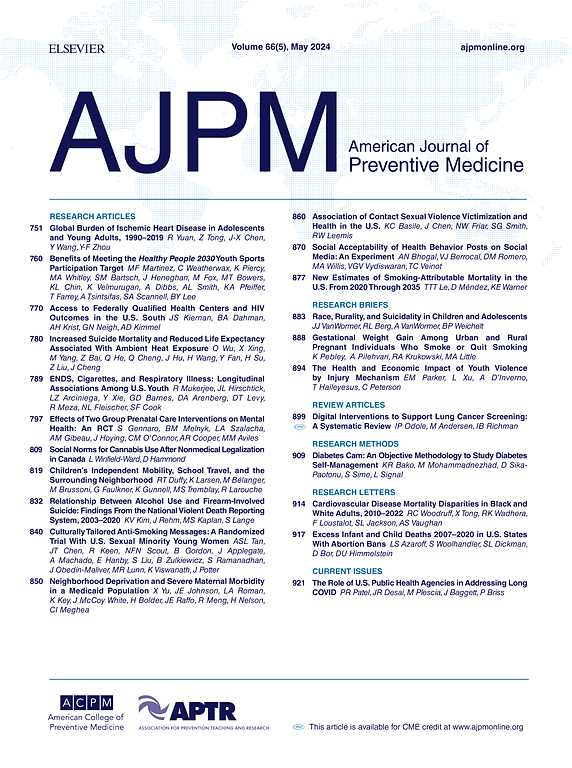Frailty and Risks of Dementia Among Middle-Aged and Older Adults: Evidence From 3 Prospective Cohort Studies
IF 4.5
2区 医学
Q1 MEDICINE, GENERAL & INTERNAL
引用次数: 0
Abstract
Introduction
Frailty and dementia are prevalent, interrelated conditions in aging populations, yet the temporal relationship between frailty progression and dementia risk remains underexplored. This study aimed to investigate how both baseline frailty and its subsequent changes over time are associated with the risk of incident dementia in 3 large prospective cohorts.
Methods
This study analyzed data from 25,357 participants in 3 prospective cohorts: China Health and Retirement Longitudinal Study 2011–2020, U.S. Health and Retirement Study 2006–2020, and English Longitudinal Study of Ageing 2004–2023. Cox proportional hazard models were used to calculate the hazard ratio and 95% CI between frailty and risks of dementia after adjusting for potential confounders. Analyses were conducted in 2025.
Results
Across all 3 cohorts, participants who were prefrail (hazard ratio=1.13–1.17) or frail (hazard ratio=1.37–1.54) at baseline had a significantly increased risk of dementia compared with their robust peers. This risk was most pronounced for those whose frailty status worsened over time; robust participants who transitioned to a frail state had increased risks of dementia (hazard ratio=2.09–2.77). Participants who transitioned from prefrail to frail showed significantly elevated risks of dementia (hazard ratio=1.32). Participants with the upper and middle tertiles of total frailty index and those in the upper tertile of change in frailty index exhibited significantly increased risks of dementia.
Conclusions
The findings from 3 large, multinational cohorts consistently demonstrate a strong link between frailty progression and an increased risk of dementia particularly for those shifting from robust to frail state. This highlights that frailty is a globally relevant, modifiable target for dementia prevention, accentuating the necessity for proactive healthcare approaches to manage its onset and progression.
中老年人的虚弱和痴呆风险:来自三个前瞻性队列研究的证据
简介:虚弱和痴呆是老年人群中普遍存在的相互关联的疾病;然而,虚弱进展和痴呆风险之间的时间关系仍未得到充分研究。本研究旨在调查基线虚弱及其随时间的变化与三个大型前瞻性队列中发生痴呆的风险之间的关系。方法:本研究分析了来自三个前瞻性队列的25,357名参与者的数据:中国健康与退休纵向研究(CHARLS) 2011-2020,美国健康与退休研究(HRS) 2006-2020和英国老龄化纵向研究(ELSA) 2004-2023。在调整潜在混杂因素后,使用Cox比例风险模型计算虚弱和痴呆风险之间的风险比(HR)和95%置信区间(95% CI)。分析在2025年进行。结果:在所有三个队列中,基线时体弱前(HRs范围为1.13至1.17)或体弱(HRs范围为1.37至1.54)的参与者与健康的同龄人相比,患痴呆症的风险显着增加。这种风险对于那些身体虚弱状况随着时间的推移而恶化的人最为明显;身体健壮的参与者过渡到身体虚弱的状态,痴呆的风险增加(hr范围从2.09到2.77)。从体弱前期过渡到体弱的参与者患痴呆的风险显著升高(HR = 1.32)。总虚弱指数在上、中三分位数的参与者,以及虚弱指数变化在上五分位数的参与者,表现出痴呆的风险显著增加。结论:来自三个大型多国队列的研究结果一致表明,虚弱进展与痴呆症风险增加之间存在密切联系,特别是那些从健壮状态转变为虚弱状态的人。这突出表明,虚弱是一个全球相关的、可修改的痴呆症预防目标,强调了采取积极主动的医疗保健方法来管理其发病和进展的必要性。
本文章由计算机程序翻译,如有差异,请以英文原文为准。
求助全文
约1分钟内获得全文
求助全文
来源期刊

American Journal of Preventive Medicine
医学-公共卫生、环境卫生与职业卫生
CiteScore
8.60
自引率
1.80%
发文量
395
审稿时长
32 days
期刊介绍:
The American Journal of Preventive Medicine is the official journal of the American College of Preventive Medicine and the Association for Prevention Teaching and Research. It publishes articles in the areas of prevention research, teaching, practice and policy. Original research is published on interventions aimed at the prevention of chronic and acute disease and the promotion of individual and community health.
Of particular emphasis are papers that address the primary and secondary prevention of important clinical, behavioral and public health issues such as injury and violence, infectious disease, women''s health, smoking, sedentary behaviors and physical activity, nutrition, diabetes, obesity, and substance use disorders. Papers also address educational initiatives aimed at improving the ability of health professionals to provide effective clinical prevention and public health services. Papers on health services research pertinent to prevention and public health are also published. The journal also publishes official policy statements from the two co-sponsoring organizations, review articles, media reviews, and editorials. Finally, the journal periodically publishes supplements and special theme issues devoted to areas of current interest to the prevention community.
 求助内容:
求助内容: 应助结果提醒方式:
应助结果提醒方式:


